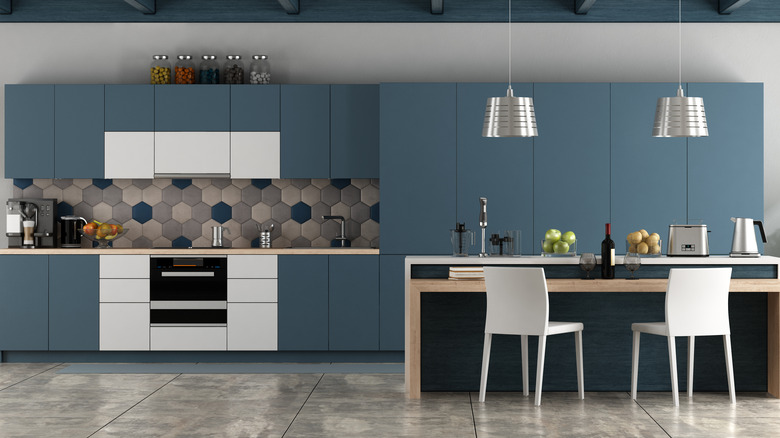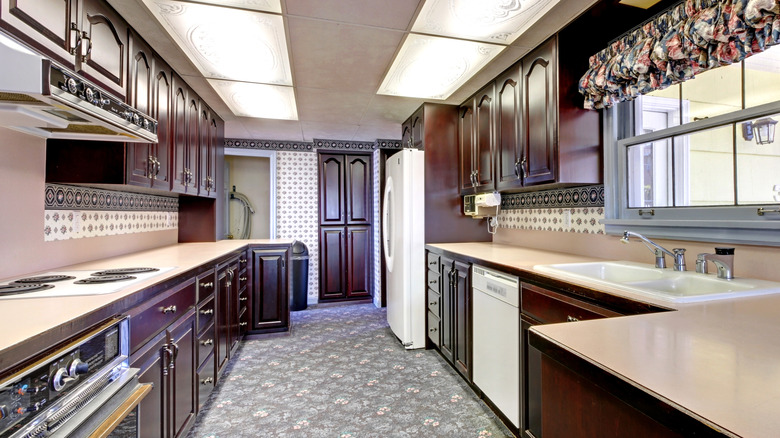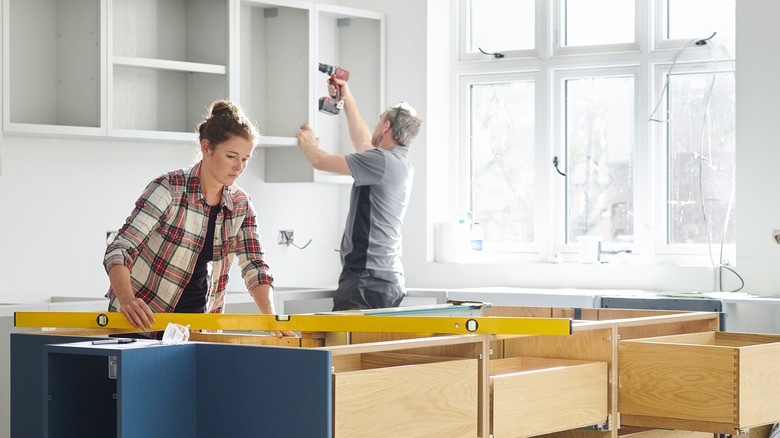Cabinet Refacing: What It Is And How To Do It Yourself Without Breaking The Bank
If you're looking to give your cabinets a modern facelift, you've probably considered replacing them. But a full cabinet overhaul can set you back thousands. The average homeowner may spend around $10,000 on a kitchen cabinet renovation, but this number can easily jump to the $30,000 range depending on the size of your kitchen and the type of materials you're using. If a full replacement is not in your budget but you still want a cabinet makeover, refacing is definitely worth looking into. Refacing your cabinets is the process of covering your cabinet boxes, doors, and drawer faces — as well as sometimes fully replacing doors and drawer fronts — with a new surface that gives tired cabinets a refresh. Rather than a full cabinet overhaul, refacing can save you money while keeping lots of construction and demolition waste out of landfills.
With the help of some sheeting or veneer, matching new doors, upgraded hardware, and a little elbow grease, your tired kitchen or bathroom can shine like new for a fraction of the cost of new cabinets. Don't be stuck with an outdated kitchen or bathroom. Instead, take the reins and try this DIY.
What is cabinet refacing?
If you look at the numbers, it's not necessarily cheaper to reface your cabinets than to replace them unless you do it yourself. Having your cabinets professionally refaced starts at around $90 per linear foot. However, you can potentially cut 50% of the total cost if you roll up your sleeves and do it yourself. The simplest option is repainting the cabinet surfaces. Another approach is placing some type of veneer over the original cabinet boxes and outside panels. This is a more elevated solution than just painting as it can add texture, gloss, and other visual appeal that paint alone can't do.
The three most common kinds of resurfacing materials are thermofoil, laminate, and wood veneer. Thermofoil and laminate are the least expensive choices. Resurfacing kits can be used for covering exposed faces on the cabinet boxes as well as door and drawer fronts. However, people often opt for new doors and drawer fronts for their DIY as it gives a polished, professional look. Along with fresh surfaces, many DIYers trick out their refaced cabinets with new hardware.
How to reface your cabinets
To pull off this cabinet facelift while keeping a few dollars in your wallet, source a refacing kit with enough material to cover not only the cabinet boxes but also the doors and drawer faces. Opt for a kit with pressure-sensitive adhesive that bonds with light pressure rather than using a heat gun or iron to melt the glue. Resurfacing kits typically come with self-adhering sheeting and tools to cut, prepare, and apply the replacement surfaces. You may need or want to buy new hinges, knobs, and drawer pulls. If your cabinet doors aren't reusable, check online marketplaces for salvage that's still in good condition. Also, see if there are businesses in your area that specialize in selling refurbished cabinetry.
Whether you're painting or applying veneer or sheeting, remove your cabinet doors and drawers and scrub all surfaces with denatured alcohol to remove grime. Once all surfaces are dry, sand and dust them off to help the new coverings adhere. Next, prepare your pieces that will cover old surfaces. Measure twice before cutting to be sure of your numbers, and add a ½ inch margin to every measurement to allow for errors. Press and smooth the surfaces, and trim any excess. Then install your cabinet doors, drawers and any hardware you're using.


